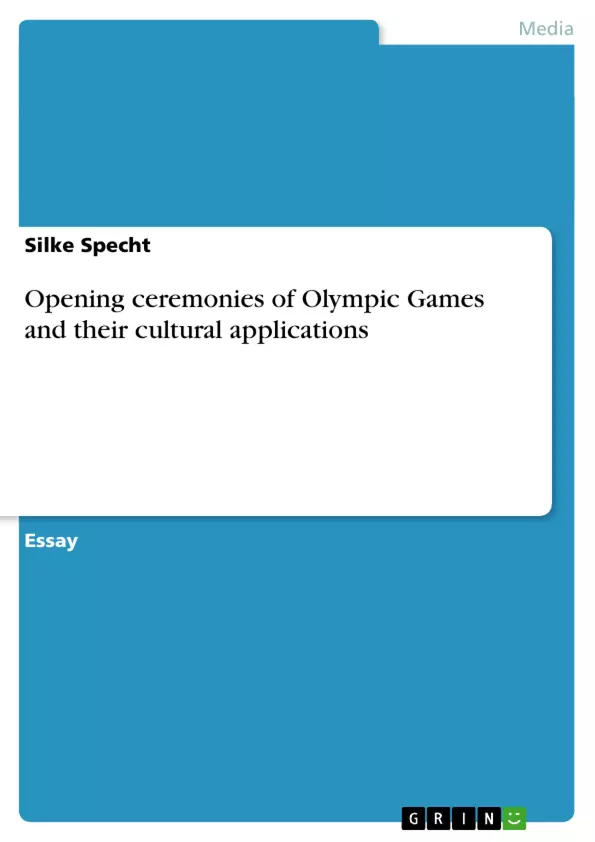The Olympic Games are without doubt an intercultural mega event. In this essay I have a look on the opening ceremonies of the two last Olympic Games 2010 in Vancouver and 2008 in Beijing. I shed light on the various cultural aspects encompassed in those ceremonies, differentiating between national and Olympic symbols, heroes and rituals expressed during those shows and analyze the underlying values and beliefs that form those cultures. In the final part of this essay I discuss the development of opening ceremonies towards national advertisement disregarding minorities in the national and Olympic societies.
I use different theories about culture and its appearance to interpret the opening ceremonies in Vancouver and Beijing. I compare both Olympics, even though it must be stated that there is an enormous difference between Summer and Winter Olympics with regard to participating nations and sports.
The idea of analyzing the opening ceremonies of the Olympic Games rests on the expectation that those were the moments at which cultural differences become most obvious for the worldwide TV audience. It is expected that especially cultural differences between the athletes can be seen during the different competitions, but as I have no source about what happened behind the various TV cameras I can hardly analyze those aspects of intercultural interaction.
Furthermore all Olympic opening ceremonies share some elements that are implemented in the idea of the Olympic movement. It should therefore be possible to find those elements, analyze their meaning for the Olympic movement and separate it from all the other ‘show’ elements that are essential for today’s opening ceremonies.
In this essay I answer the question how we (the non-host community) perceive the host nation’s culture as it is expressed during the opening ceremony.
I also analyze critics of the Olympic opening ceremonies, not only concerning the ‘ignorance’ of minorities, but also the use of ‘fakes’ to make the whole ceremony look bigger and more glamorous than it really is. I will also pace the question whether it is really necessary to make every new opening ceremony bigger and more expensive than the ones before and whether this does clash with the values of the Olympic movement.
Inhaltsverzeichnis (Table of Contents)
- Introduction
- Theoretical considerations
- Analyzing Cultural Aspects in the Opening Ceremonies
- The Opening Ceremonies of the Olympics - Beyond National Advertisement
- Conclusion
Zielsetzung und Themenschwerpunkte (Objectives and Key Themes)
This essay examines the cultural aspects of the opening ceremonies of the 2010 Vancouver and 2008 Beijing Olympic Games. It aims to analyze how these ceremonies reflect national and Olympic values, beliefs, and symbols, and to explore the evolution of opening ceremonies towards a focus on national advertisement. The essay investigates how the ceremonies portray cultural differences for a global audience and discusses the role of minorities within national and Olympic societies.
- Cultural representations in Olympic opening ceremonies
- The impact of national identity and values on the ceremonies
- The evolving nature of opening ceremonies towards national advertisement
- The portrayal of minorities and diversity in the ceremonies
- The role of cultural symbols, heroes, and rituals in the ceremonies
Zusammenfassung der Kapitel (Chapter Summaries)
The introduction sets the context for the essay by outlining the focus on cultural aspects of the opening ceremonies and the use of theoretical frameworks to analyze these elements. It highlights the importance of understanding the cultural differences reflected in the ceremonies and how they contribute to the overall experience of the Olympic Games.
The chapter on theoretical considerations provides a foundational understanding of culture and its manifestations. It explores various definitions of culture, emphasizing the role of mental programming and shared values within different groups. The chapter also discusses the concept of national culture and its complexities, emphasizing the potential for both integration and differentiation within a nation. The chapter highlights the use of symbols, heroes, rituals, and values as indicators of cultural expression and examines their respective levels of manifestation.
Schlüsselwörter (Keywords)
The main keywords and focus topics of this text include Olympic Games, opening ceremonies, national culture, cultural representation, intercultural communication, symbols, heroes, rituals, values, minorities, national advertisement, diversity, and Olympic movement.
- Quote paper
- Silke Specht (Author), 2010, Opening ceremonies of Olympic Games and their cultural applications, Munich, GRIN Verlag, https://www.grin.com/document/232180



